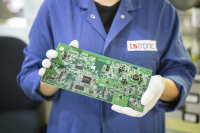The purpose of a power divider is to achieve the division of power while maintaining:
- the biggest possible port-to-port isolation,
- the lowest possible insertion loss and voltage standing ratio,
- the least possible amplitude and phase imbalance over the entirety of the frequency range of the device.
Power dividers are often referred to as splitters. Between engineers, however, the term “splitter” is used mostly to describe an inexpensive resistive structure that splits power over very wide bandwidth, but has considerable loss and limited power handling. There are three main types of power dividers: Wilkinson power dividers, reactive power dividers, and couplers.
Wilkinson power divider
The Wilkinson power divider is a device composed of simple transmission lines and a resistor. It takes advantage of the properties of quarter wavelength transmission line sections to provide ideal power divider characteristics. The Wilkinson power divider can be also used as a power combiner, where the structure takes two input signals of equal phases for combining. The device offers outputs with both equal phase and a broad bandwidth of approximately 1 octave. The Wilkinson power divider is commonly used in the RF and microwave community.
Reactive power divider
Reactive power divider is essentially a Wilkinson power divider with a deleted isolation resistor. They are often used in antenna feed networks. Due to their limited isolation, reactive power dividers are not recommended for power combining.
Couplers
Couplers are power dividers that divide the power in an uneven way. In devices of this sort some small portion of the signal is being split off to one output port, while the remaining, bigger percentage of the signal goes through to the port.
The application of the power divider
Power dividers can be applied in:
- the microwave technology, where it is crucial to combine power from several inputs and distribute input power into several outputs,
- the microwave communications, mostly in the microwave stations and the satellite earth stations,
- wireless communication systems, mainly devices such as power amplifiers, mixers, active circulators, and phase shifters,
- communication circuits, mainly ultra-wideband circuits, antenna array systems, and RF front modules,
- the field of radio technology, where it is necessary to combine a determined amount of the electromagnetic power in a transmission line to a port, which allows the signal to be used in another circuit.
Installation of the power divider lock – when is it useful?
The installation of the power divider lock is advisable in the electrical installations, where it is easy to exceed the set value of power consumed by the device. Power divider locks, known also as limiters, are a very effective and relatively cheap method of protection against electricity theft. They are also incredibly useful in case of high voltage spikes. In microwave paths, power divider locks prevent destruction of the circuit in the event of a sudden signal power surge.
The CS-Lab Shop offers a high quality Power Divider 24 VDC which can be used for the division of a 24 VDC logic power in a CNC machine in a safe and aesthetic manner. The device is equipped with a LED diode that indicates the presence of power. The main advantages of the Power Divider 24 VDC are great simplicity and extreme functionality. Every user of the device needs to remember, that it is forbidden to connect the power higher than 30 VDC, as it may lead to the destruction of the LED diode.
partner article








